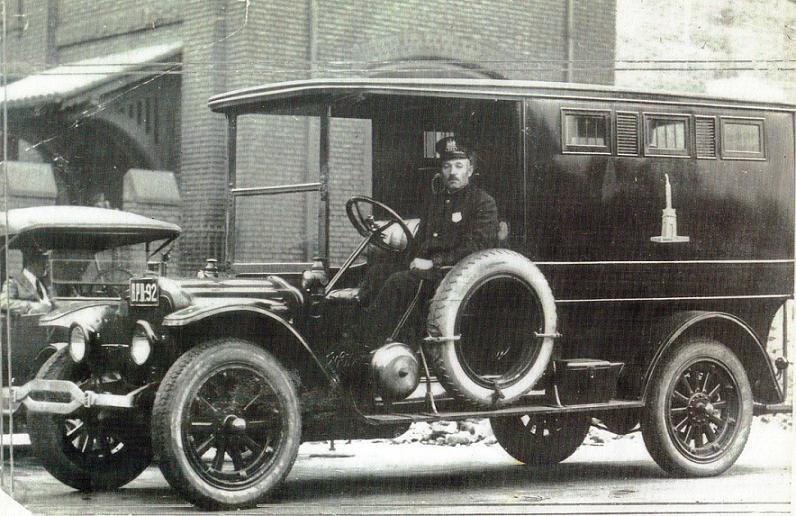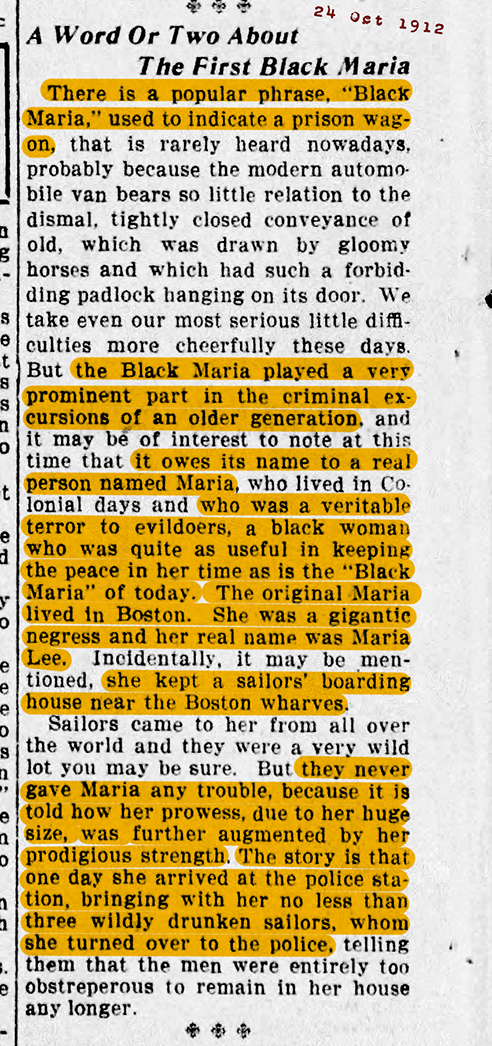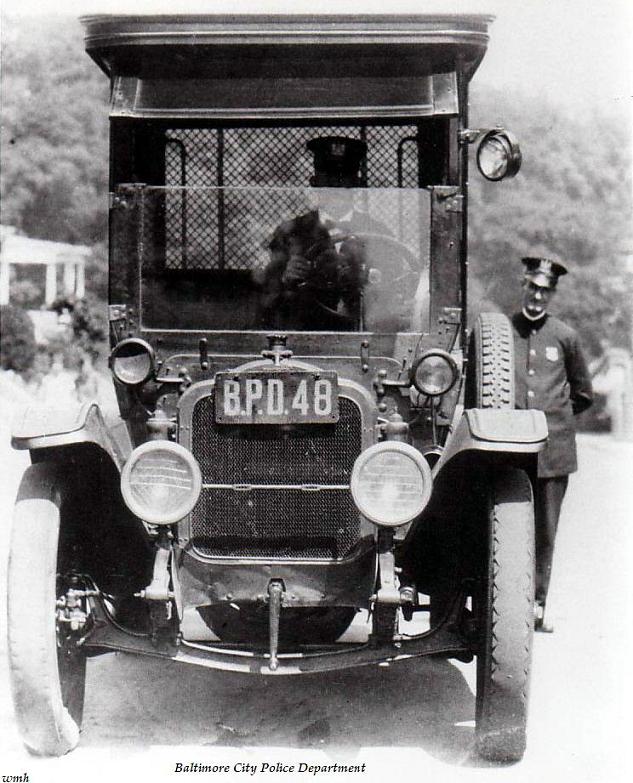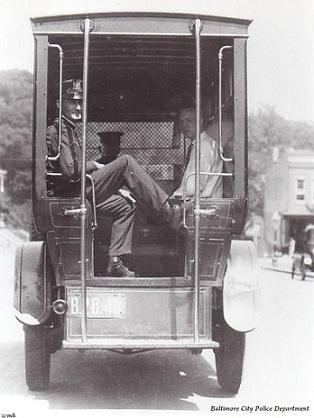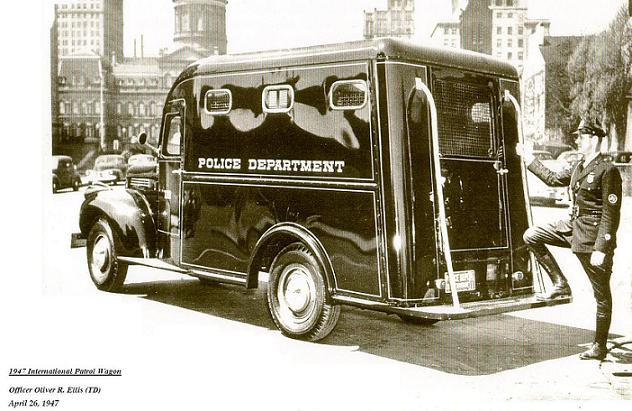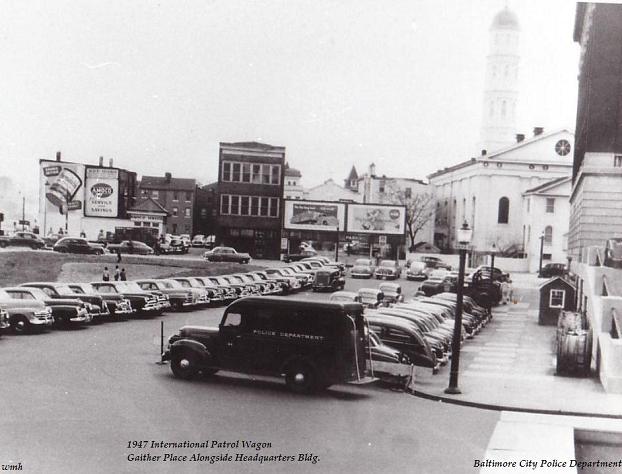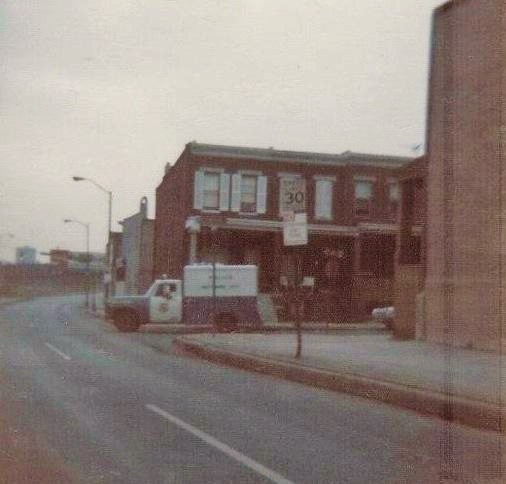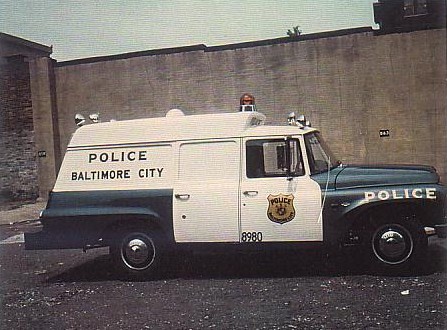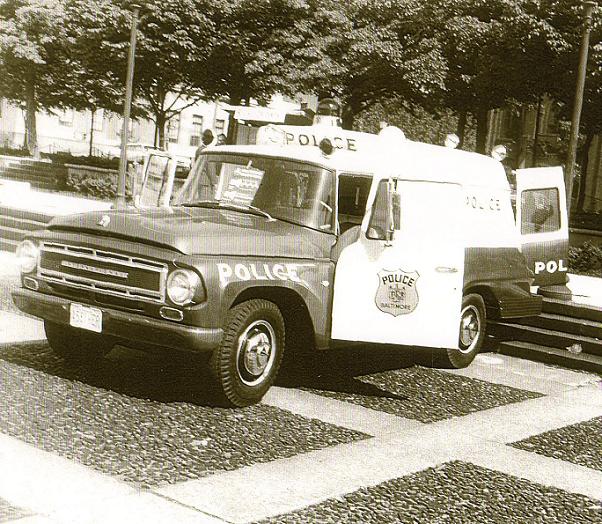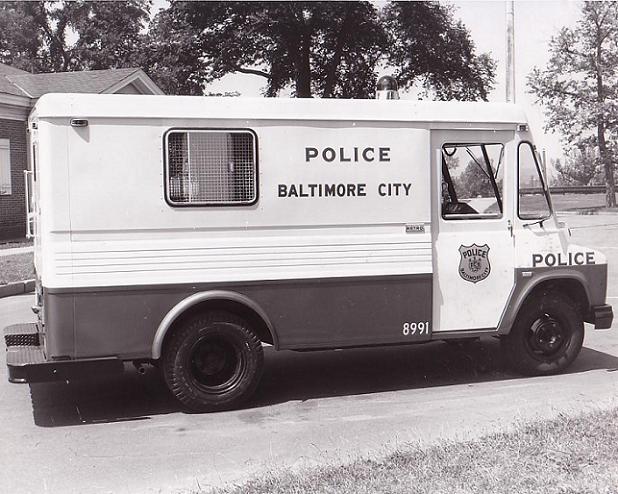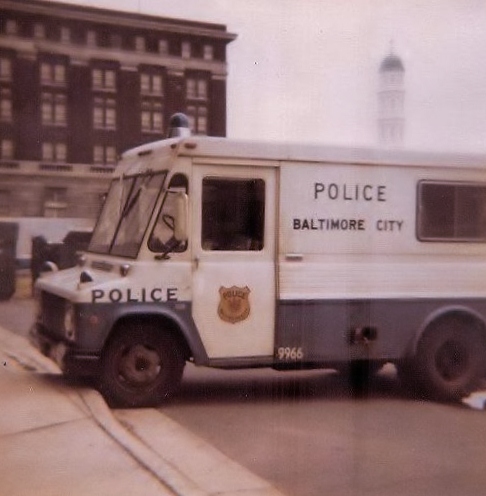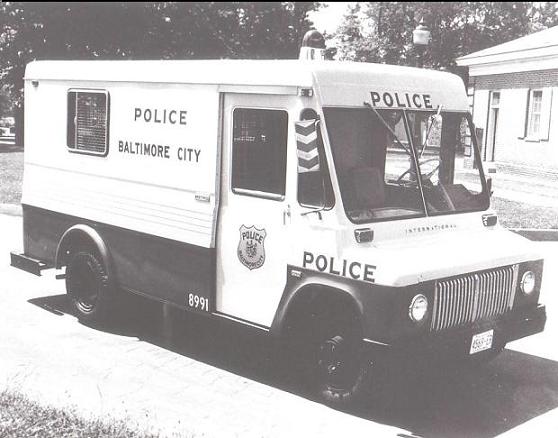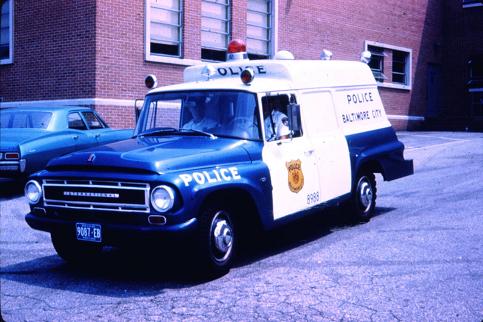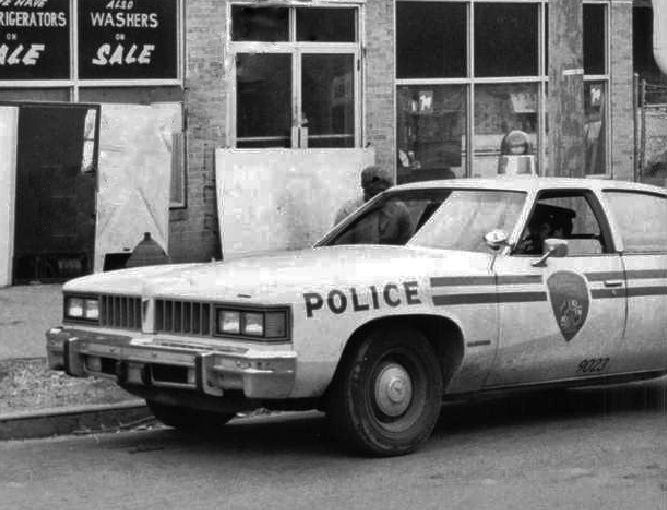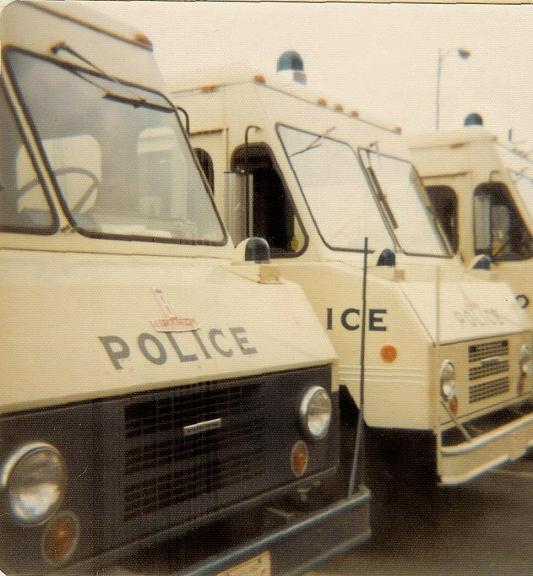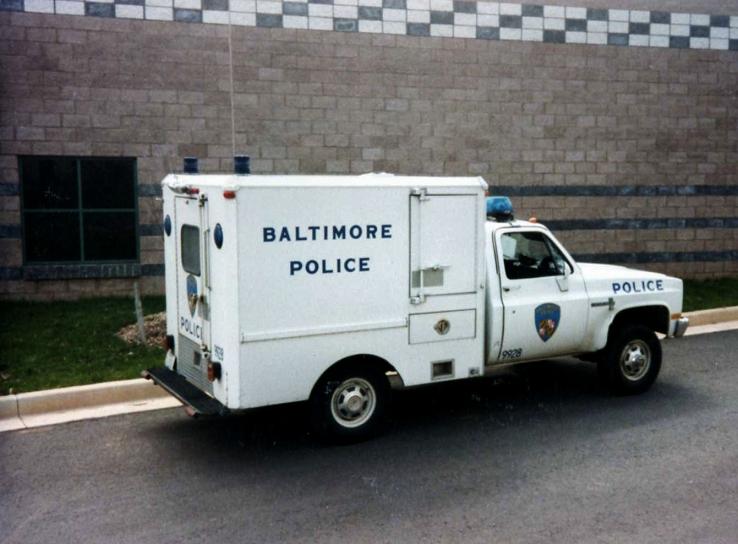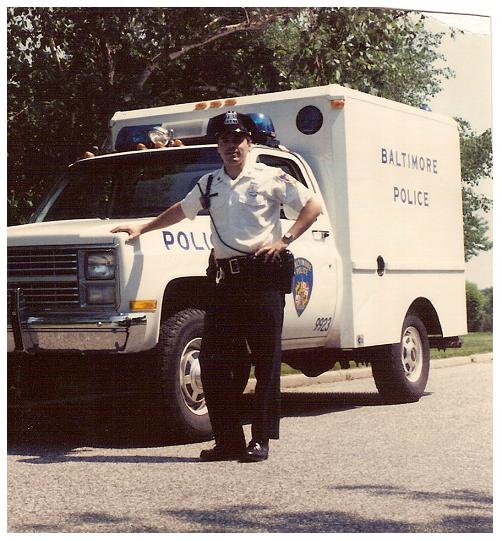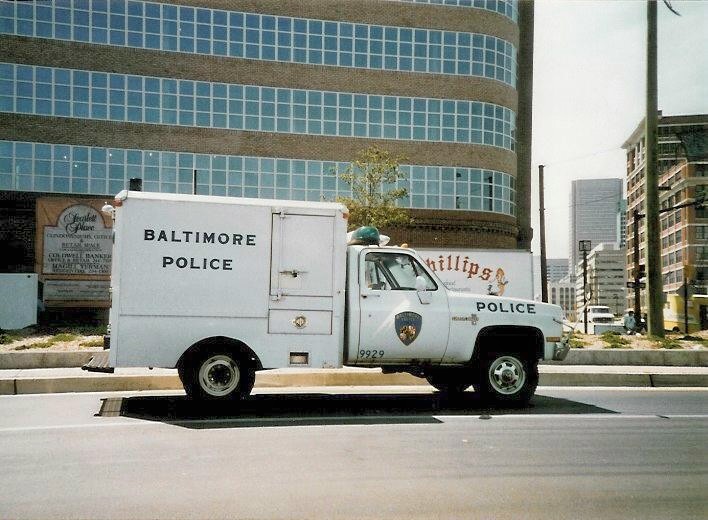Patrol Wagon History
The Patrol Wagon first came to Baltimore in 1885 as part of a package deal put together by then Deputy Marshal Jacob Frey after the Deputy Marshal first saw a Patrol Wagon in use by the Chicago Police Department in a copy of an illustrated newspaper most likely Harper’s Weekly. The other item found in this package deal was the Call Box. For more information please take a look at the Call Box page and the Recall Light page, both on this website. at the following links. Click on either Call Box or Recall Light to visit either of these pages, and look for other links found within these two pages. We also found the history of the term Black Maria and several therories on the term Paddy Wagon they can be found Here.
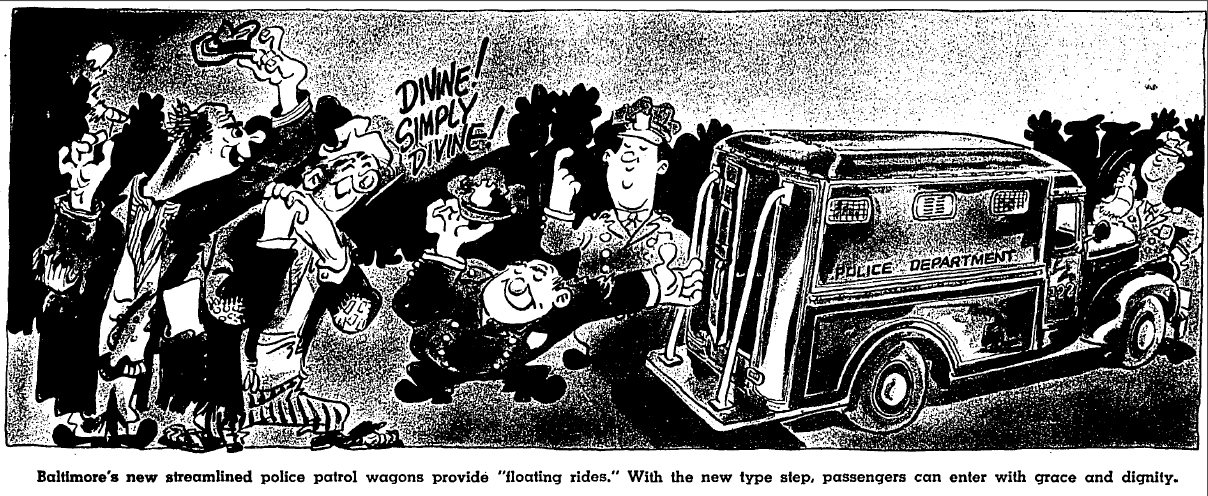
Wagons in a Pinch
29 June 1949
BY THE FIRST-HAND TESTIMONIAL, Baltimore’s new police wagons are vehicles in which their passengers are proud to ride. They are roomier, more fordable, faster, of smarter design and, in dozens of other ways, a world of improvement over the department's former free transportation fleet. The enthusiasm of the passengers is appreciated, but not unexpected Lieut. Leroy Kues, director of the department garage, had the patrons' comfort high in mind when he designed the new model. The new wagons are in service now at most of the department's eight district station houses. By October they will have replaced all of the old vehicles, most of which have been in continuous service since the 1930's.
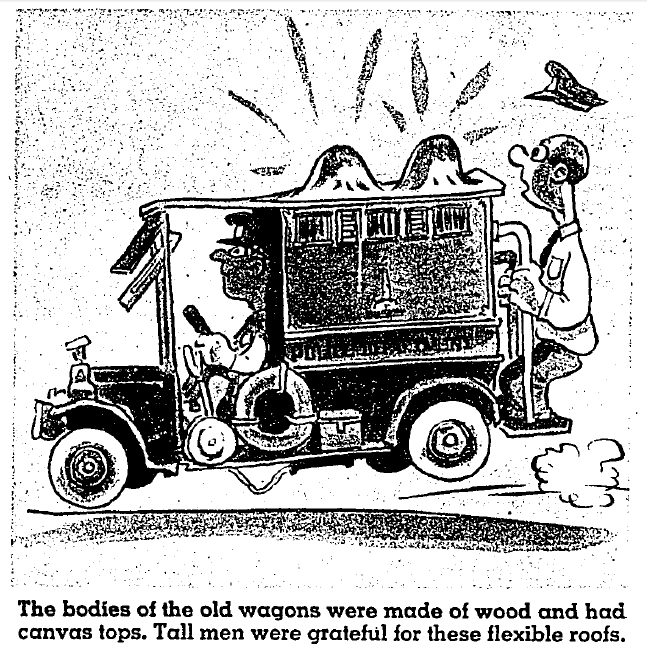
MECHANICALLY speaking the new wagon Is a streamlined, all-steel detention compartment of "teardrop" design mounted on the light. low chassis of a six-cylinder truck. The new chassis provides a "floating ride," police say, in welcome contrast to the old wagon, "which rides like a stone truck." The new compartment. constructed and mounted by the same Baltimore carriage firm that made the old wagons, is sold as I did that it can be lifted from a worn out chassis and mounted on the new one. Its service expectancy is roughly that of four or five chassis or about 20 years. The most apparent improvement or those that have been made out of consideration for the passengers. The facing bench seats or panel made out of oak that goes between the detention compartment and are considerably larger than the old vehicle. There’s more room for them. They could seat up to a dozen passengers comfortably.
IN A PINCH the old wagons accommodated a dozen passengers. But they had to sit six to a side with their knees interlocking in the narrow aisle between them.
This made for an uncomfortable ride at best. That is even if the passengers were no more than casual acquaintances. When the passenger list included participants from both sides of the street brawl, the cramped quarters presented a situation that age two men before their time. The late models for a mere interior also provide a new convenience for the in disposable Saturday night passenger traffic. It accommodates for persons at full length. Lights in a detention compartment of the new wagon are sunken into the marine plywood paneling. In the old model, they were protruded from the ceiling and many a customer has complained about bumping his head against them. Other popular innovations of the new model or its loading platform and entrance. These are wider, lower an illuminated by the tail light. It was impossible for the passengers to enter the old wagon with any degree of grace and dignity. Particularly if the passenger was a lady. Negotiation of the 228 in steps could be affected and only by the use of both hands, considerable exertion and the help of a policeman. On some of the tavern rates, it took two policemen. But the new wagon has in 18 ends. Then a 14 and step which can be mounted easily and casually without assistance. The riding qualities of the whole vehicle had been improved by double action shock absorbers
STRUCTURAL changes have also been made for a more contented police force. The new wagon Carries this or and under the hood. Away from the weather, the old wheezers were mounted on the outside and would not sound off at full power after a hard rain. The wagon had to pull up to emergency trailing a thin pitiful wail that added an error of frustration to the whole arrest.
FURTHERMORE the siren tone that emanates from the hood of the new wagon is a sharp, shrill cry of authority that doesn’t whimper for, but demands, the right of way. An improvement in the design of the foot men’s handrail at the rear of the new vehicle had safety and convenience to the man on duty there. On a cold type wagon, the handrails rammed the full perpendicular height of the rear. Protesting, passengers sometimes grasped the rail, lifted themselves up and lashed out with their heels at the policeman behind them. A man once Lawson high that way. Several others lost teeth, a nephew suffered broken noses. On the new wagon, the rails are shorter to prevent this sort of thing.
THE NEW MODEL has a built-in buzzer system from the foot men’s position to the chauffeur. For nearly an hour these men shouted instruction to each other. The signal system is expected to result in more efficient starts and stops and add to the general comfort of the passenger by eliminating a lot of police department shoptalk and from them. Improvements to the chauffeurs can give the new model about 25% more flour and seat space and then the old. In the crowd model that is being retired, even policemen of average build had to squeeze themselves and carefully to get behind in the steering wheel. But sergeants can drive the new vehicle.
THE SQUARE SET WINDSHIELD and clapping side curtain of the old model wagon held the chauffeur’s visibility to a minimum, even in clear weather. The new vehicle has conventional wide truck windows in the cab and a clean windshield with about 20° pitch. The spare tire that once rode the front left fender and prevented the show for prince wing and his door wide open is now carried in a compartment beneath the rear quarter the driver’s door is also wider so that he no longer has to back out of his cab to help with an arrest. Construction of the new type wagon is the fourth major improvement made in the Police Department's free-transportation system. During the first years of the department, patrolmen would have their "customers" walk in to see the desk lieutenant. Indisposed ones were trundled by wheelbarrow.
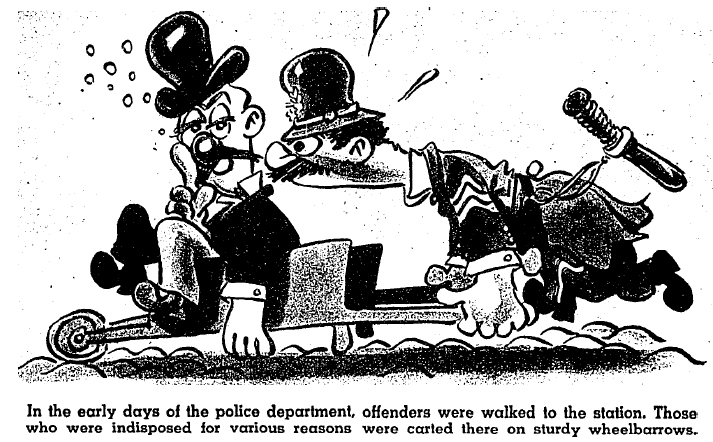
LATER HORSE·DRAWN WAGONS (18 October 1885) were put into service. That was a high-wheeled, open-air delivery-type wagon equipped with a driver, a span of good horses and two nimble footmen to bring back those customers who vaulted over the side and made a break for freedom. Shackles final1y were added to the wagon, for the more difficult passengers. At the turn of the century, when Central district headquarters was on North Street (now Guilford Avenue), an electric runabout supplemented the horse-drawn vehicles and a few wheelbarrows. The horses and barrows made runs while the electric runabout was out of service-it had to plug in at the Station-house and recharge for an hour after each trip. The first motorized vehicles used on a large scale by the department- they were introduced a few years before the First World War - were of about the same design as those now being retired.
THERE ARE POLICE IN BALTIMORE who claim that the retiring wagons operated on ten percent gasoline, 30 percent memory and 60 percent sense of duty. That isn't entirely true but the claim is understandable. All of the old wagons had exhausted their sets of valves and cylinders until the police mechanics lost count.
The wagon in the Southwestern district, the one some of the policemen called Eleanor, had 293.900 miles to her credit. Her crankshaft became grooved so deeply that the department mechanics had to turn the whole shaft down to 90/l000ths of an inch undersize. That cut down her limping to a great extent, but she continued to suffer from an asthmatic condition until she died at the scrap-yard. The demise of Bronchial Bill and Old Hopeful at other stations followed similar illnesses.
ALREADY THE WAGON set is referring to the new vehicle as Black Maria. That is a title all police vehicles fall heir to, but now the title has a note of respect. One of the first passengers asked the footman if the ride in the new machine would cost him extra when he faced the magistrate. When Southwestern’s new wagon made its first run to the House of Correction. Several inmates who had been taken there just a week earlier were resentful because they had been hauled in "the old stone-wagon." But there's little call for quibbling now. The new wagon will be here for the next twenty years, and the police say there will be a chance for everybody.

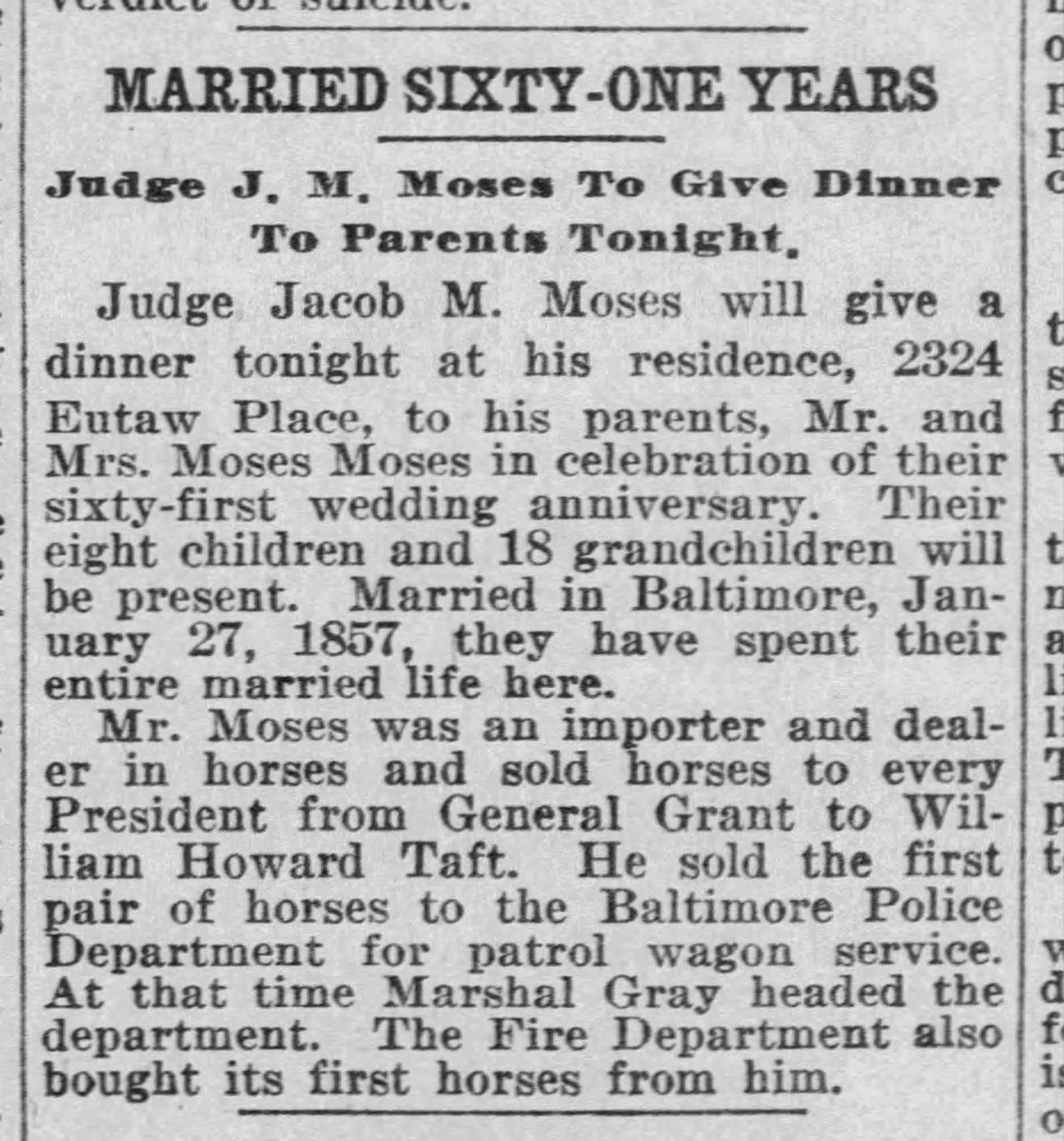
First Horse sold to the department for use on our first Patrol Wagon/Ambulance
Article Printed on 25 January 1918
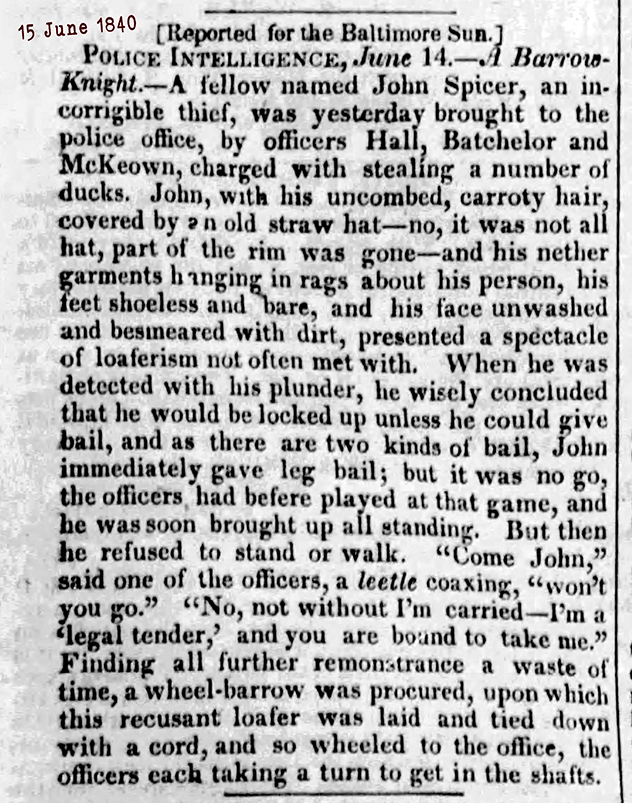
To See the Full Size Article Click HERE
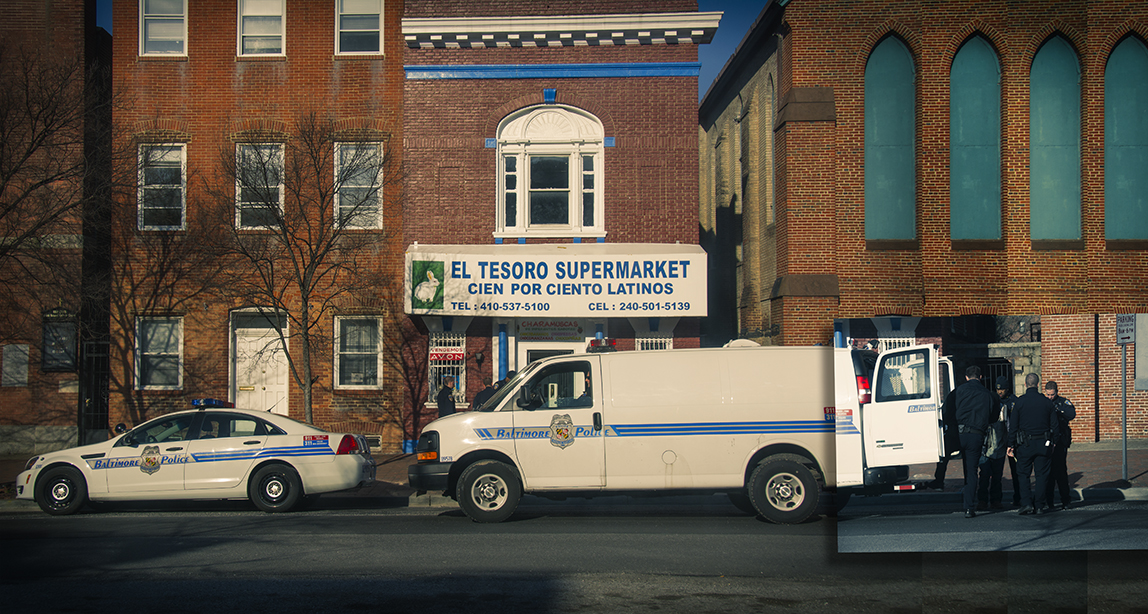
Photo Courtesy Det Kenny Driscoll
Shot on Broadway, obviously, two pictures put together for a unique look
Brian Kuebler wrote BALTIMORE - Citing efficiency and safety, the Baltimore Police Department is making yet another visible change in its division by eventually decreasing the use of prisoner transport vans. This information comes as a surprise to many of the members of Baltimore’s division, as they fear the safety issues are not at the root of this change. Having worked myself, I happen to know if ever there was a concern for officer safety it is not while the prisoner is in a wagon behind, or in front of an officer's vehicle, so much as it is with the prisoner in the vehicle a little less than 2-ft behind the officer. There are instances of prisoners vomiting, urinating, and or defecating on themselves in the vehicle, or having concealed weapons that could be used to stab, or shoot the officer from behind. So this could be, and most likely is more than an officer safety issue, and is most likely an issue of budget. Either way, safety or budget, it is not about, nor will it affect (in a positive light) officer morale. He went to say The cage equipped vans, or wagons as they are commonly referred, are used to transport suspects from the scene of a crime or an arrest. Often Baltimore Police would process and handcuff suspects before calling and waiting for a transport vehicle. They are more commonly known as “Paddy Wagons” by the public, a derogatory term aimed at the Irish dating back to the 1800s in New York. While there is some truth to this, in that is was aimed at the police most of whom were Irish, and from the time period of the 1800's, but the location is off, it was Boston, not New York, and at the time we pretty much all used "Horse Drawn Wagons", hence the term "Wagon" of course the police at the times were mostly Irish, so yes, it was a "Paddy Wagon". When I was on in the late 80's to early 2000, we still called it a "Wagon", we used a box truck type wagon, much like an ambo, and we called it Wagon, short for "Paddy Wagon" also as an Irishman, I don't think it is derogatory, in fact as a retired Officer, of Irish descent, I am proud to have come from a background of Strong Irish Law enforcement officers, known for fighting crime. The article continued with - But that is not why modern-day Baltimore Police are doing away with their frequent use. In Brian's investigation into this story he learned from Lt. Eric Kowalczyk the cars, will all become PTV's (Prisoner Transport Vehicles) something we used to call "Cage Cars" talk about derogatory, it was called this because the first cage cars, were made up simply by putting a thin cage between the officer's and their prisoners. Often spit would fly between the cage, and toward the officers, so the cage was replaced with Plexiglas to prevent anything, spit, blood or other bodily fluids from being thrown at, or on the police. So when Lt. Kowalczyk said, “In our new vehicles we have made a number of changes and upgrades regarding equipment and tools that will assist our officers in the crime fight. One of those changes will be partitions in the vehicles. These partitions will assist in ensuring the safety of those involved in the arrest, as well in expediting the event itself. They will still allow for complete mobility within the vehicle,” We learn this is more about economics than safety, this is nothing new, it is more of the same old "Cage Car" prisoner transport of the late 80's early 90's - Which is confirmed with the final line - Prisoner transport instead will be done more with individual cars.

From here they went on to say the following which talks about the vehicle's paint scheme - and for this, they, write - ABC 2-News was the first to reveal the new design Baltimore Police squad cars. Starting with about 30 vehicles in the most recent procurement process, Baltimore will be switching to black colored Chevrolet Caprices with a blue logo. Baltimore is not new to the black car, it hasn't been black for a while, but black is not new to BPD; in the 20's we had black cars, in the 30's, the 40's the 50's, 60's and then sometime in the mid 60's we moved away from black cars, along came the some blue and whites; that carried into the 70's before we went to the white car, the white car swapped stripe patterns a few times. In the early 90's we used a powder blue ford, it didn't last long before we would go back to the white, with a much nicer decal design, and the modern badge on the door in place of the shoulder patch, or police logo. The Commissioner (Anthony Batts) said the officers themselves chose the design, and it was done to boost morale, in the quote he said, "When they are in those cars, that is their office for eight to ten hours a day, that is their office so what I did is I allowed them to design what they wanted out of their police cars" The article went on as follows pointing out things that most followers of the department have said, and BTW liked about the new design, The logo is modeled after the one seen on the department’s choppers and mobile command units. But the change isn’t in just the look of the vehicles. The cages will be installed in the squad cars so that the driver’s seat may be maneuvered for comfort, a simple feature some officers said was not available in all previous iterations of Baltimore Police cars. "We had already prepared to bring in about 165 cars. Some of those will be white because we didn't have time to change up the colors but we are looking to start to have all the cars go to the shape and style that the officers had asked for," the commissioner said. As the new squad cars take to the streets, the more prisoner transport vehicles will come off. It is unclear if there is any timeline for the complete switchover, but the police department says ultimately the move will make policing more efficient and eliminate wait times when a wagon is called. “While wagons remain a vital part of our deployment these newer vehicles, and the resources they provide, are adding to the efficiency and safety of both officers and citizens,” Kowalczyk said. Copyright 2014 Scripps Media, Inc. All rights reserved. This material may not be published, broadcast, rewritten, or redistributed.
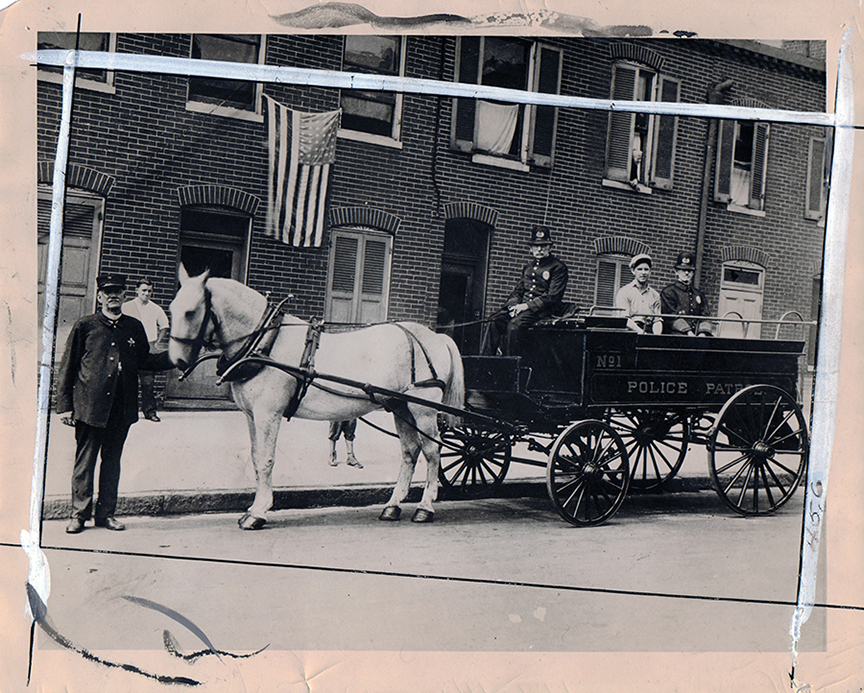
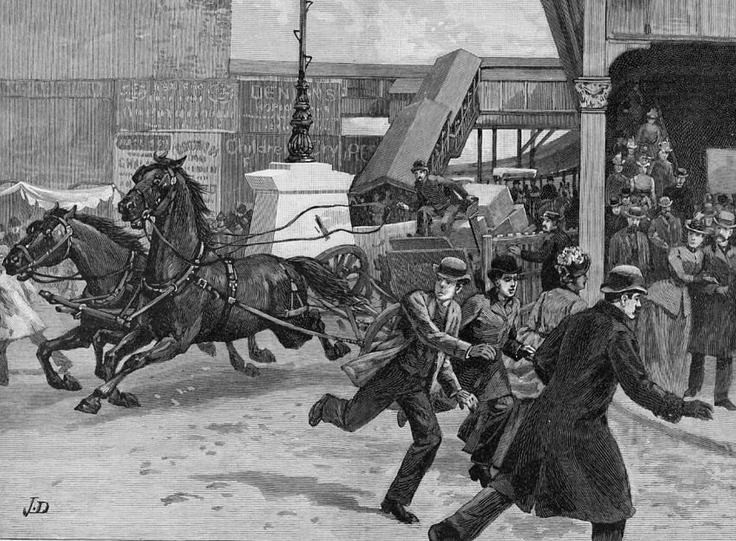
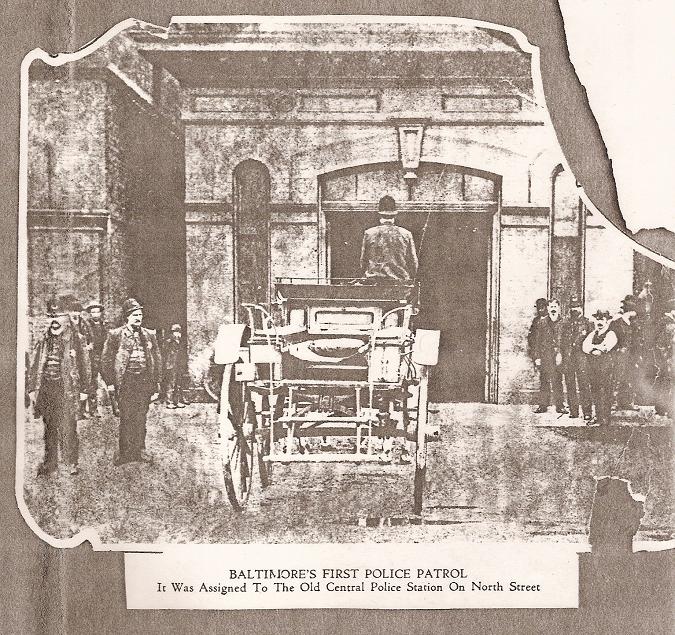

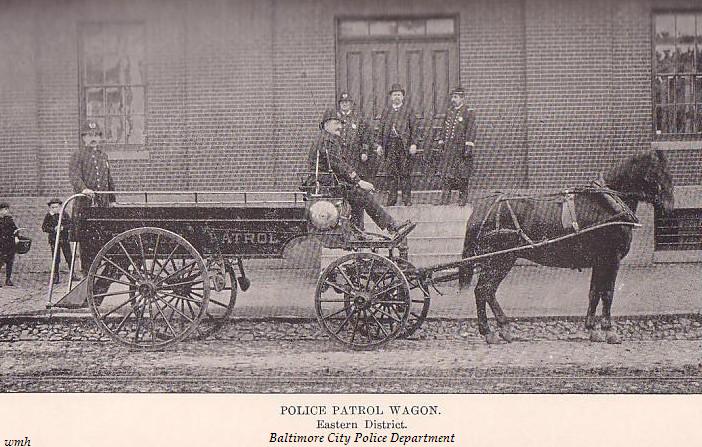
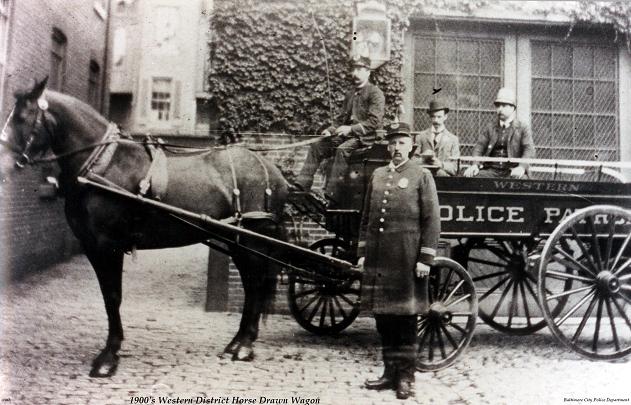
COURTESY SGT. ROBERT FISCHER
1880'S HORSE DRAWN WAGON

Pictured above late 1800's-early 1900's Baltimore Police horse-drawn carriage
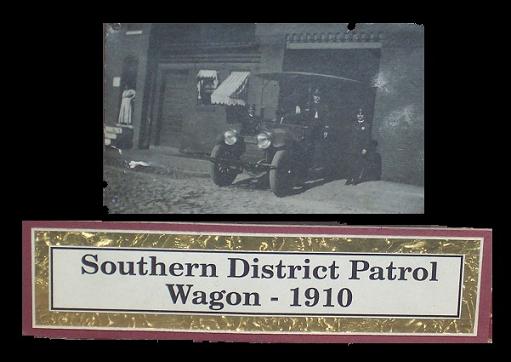
COURTESY BALTIMORE POLICE DEPARTMENT

1890's Wagon Purchased for BPD Museum
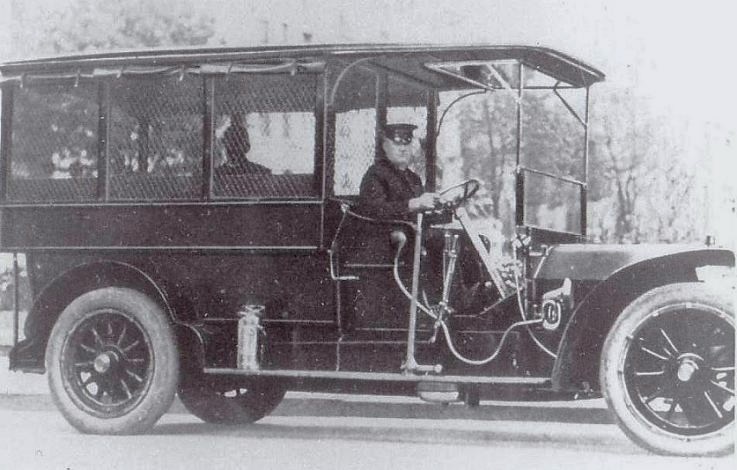
Photo courtesy Sergeant Robert Fisher
Photo Courtesy Sergeant Robert Fisher
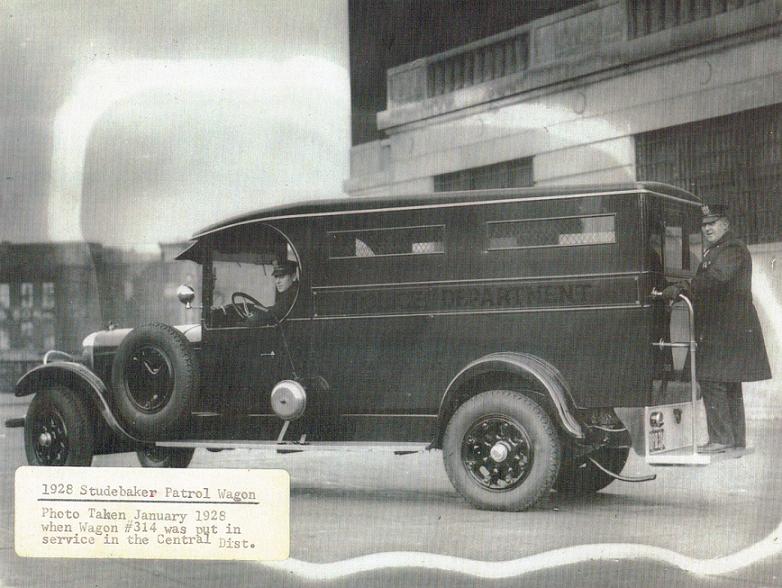
Photo Courtesy Sergeant Robert Fisher
1928 Studebaker Wagon #314 D
COURTESY SGT. ROBERT FISCHER
1920'S WHITE WAGON
SIDE VIEW MIRROR AND AN AWNING GRACE THIS VINTAGE WAGON.
NOTE THE BATTLE MONUMENT INSIGNIA ON THE SIDE.
Where the name "Black Maria" came from
Click HERE to see full size article
1920's POLICE WAGON
"Black Maria"
Front
1920's POLICE WAGON
"Black Maria"
Back
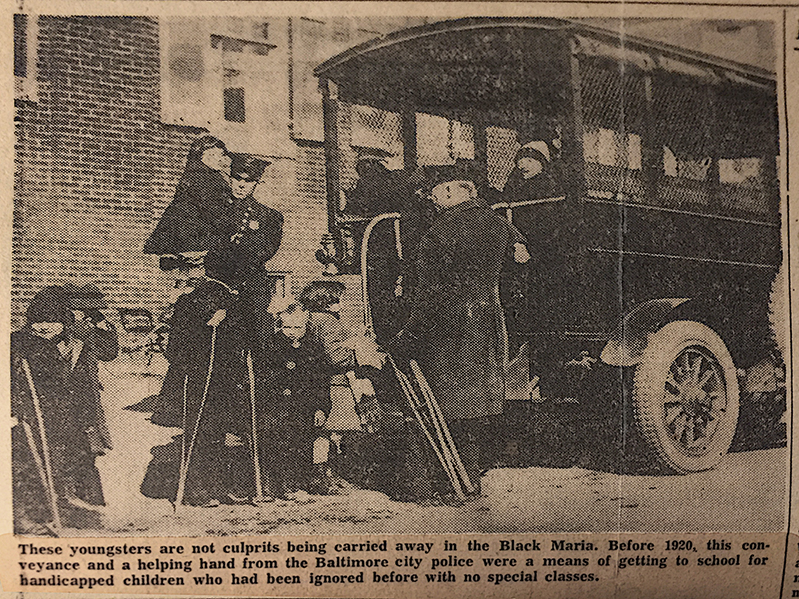
Black Maria Served as First School Bus
[Late teens 1900’s]
Black Maria - A Black Maria of the Police Department used to transport crippled children to school in Baltimore in the late teens years of this century. And the children loved it, despite the ominous name given the transportation. For most of them, it represented the only way they could get to school, hampered as they were with braces and crutches. Besides, most of them had never ridden in a motor driven vehicle before. The fact that there was any transportation at all for handicapped children at that period was largely the result of the stubborn determination of a young girl a Baltimore who has been described as “the spark and the flame,” of what is now the Baltimore league for crippled children and adults: Isabel Kann Frank.
Best Narrator - She, perhaps, better than anyone else can describe the slow evolution which went from provisions for handicapped children to the league’s 36th anniversary this year in the field. Mrs. Henry L Frank was the founder of the league and still spends every day at the league’s headquarters on Greenmount Avenue. The league, coincidentally, is conducting its Easter Seal drive for funds for its activities through April 14. Baltimore 50 years ago had no provisions for formal schooling for the more severely handicapped children who were destined to watch, from their windows, at the other children swinging their book straps on their way to school. “When I was a little girl on my way to Girls' Latin School, I used to pass the crippled children’s hospital at Charles and 20th streets. I would see the children at the windows, day after day. I used to wonder if anyone was teaching them to read and write. Dr. R. Turnstall Taylor directed the hospital, and one day after building up my courage, I walked into his office and asked him if there wasn’t something I could do to help the children. Dr. Taylor was amused, but he said I could come in after school and teach the children. “In those days the attitude of a great many people was, “Nobody can do anything for these children – it’s just an act of God.” Once they had bought braces and shoes, they had done their job. “I was only 13 then, but my interest in these children never flagged. When I was a little older I joined the guild for crippled children which was formed in 1889. Theirs was a pioneering effort in the face of public apathy. In 1913 there was still no convenience to carry the children to public schools and no special facilities or classes. But in that same year, when Mrs. Robert Laucheimer was chairman of the committee, we were told two classrooms were being made available for the children if we had a way to get them there! “Undaunted, the committee went straight to the Della Transfer Company on Race Street and hired a horse-drawn omnibus. What a day that was when the “Elsie” clattered over the cobblestones and the "clop-clop" of the white horses alerted the children on their first day at school!
Help Children - “The driver would stop each morning to help the children into the bus – some of them had to be carried, but all of them had to be helped with their crutches and their braces. After school, the bus would call for the children and deliver them happily and safely to their doors. “The first two schools to experiment with this program for the handicapped were General Henry Lee Elementary School at Hanover and Lee Streets and Sir Robert Eaton Elementary School at Preston and Eden Streets. The children not only had their lessons in the schoolroom, but they also had their soup and cocoa warmed on a hot plate. I remember replacing the odd, crippled assortment of cups, plates, and cutlery with shiny new equipment. “As thrilling is the omnibus arrangement was, the guild found its meager funds would not stretch to continue hiring transportation.
Cooperative Police - “And so, a cooperative Police Department came to the rescue with the Black Maria and the Motorcycles with Sidecars. That was another first to remember when the police officers, of Baltimore City with tenderness and devotion, carried the little ones back and forth. Of course, the children were wild with the delight at motor transportation and would triumphantly waive their crutches as they went by. “In 1921 I became chairman of the guild and proposed to the parent Council of Jewish Women that it merge with the guild’s efforts into a new professional organization to serve the crippled children throughout Maryland. From this proposal, the Maryland League for Crippled Children was organized in 1927. In 1952 it affiliated with the Easter Seals and became the Baltimore League for Crippled Children and Adults, Inc. “The project of organization became more and more exciting as we chalked up progress, slowly but surely. There were many fine professional people who worked untiringly, but I expected that I was the chief “pesterer” spending hours in the offices of prominent doctors and businessmen until I could tell them my story. I took about a year to finally complete the distinguished board of directors for the League. The honorary vice presidents were Judge William C. Coleman, Jacob Epstein, Frank A. Furst and Dr. William Welch. Dr. George E. Bennett organized the corps of young orthopedic doctors to volunteer time and provide their own travel expenses to man crippled children clinics throughout the State of Maryland. “After the League’s organization, the big goal was modern, specialized school buildings and staffs devoted to the instruction of the children.
Demand Action - “Dr. William S. Baer, Dr. Bennett, and other eminent medical authorities and civic groups demanded action. At long last in 1931, the Maryland Legislature passed an act enabling the creation of two modern schools for handicapped children in Baltimore. By 1933 the William S. Baer School was erected at Warwick Avenue, and the Francis Wood School for Negro children was completed at Franklin and Schroeder streets. “Among the names to be remembered for outstanding service through the organizational and build-up years of the League are those of Ellen Krause, first employee; Mary E. Church, first director of the League; and Miss Margaret Huffington, assistant director of the League, who came on duty the first day the league opened its doors in 1927. When the Doctor William S. Bear School opened its doors, a beautiful shiny motor bus delivered the children in style. My husband who stood there with me said, “you’re very excited, aren’t you?" and I said, “I’ve never been so excited in my life!” “How about the day you were married?”. He teased. “Oh well,” I said, “I expected to get married, but I never expected this dream to come true!” “Memories of those early days are a real pleasure, but the present has its satisfaction, too. When I see men and women who once rode to school in the wagon, the Black Maria, and other school buses, now educated and trained occupying useful positions in the community, the efforts of all those who helped seemed very worthwhile.” NOTE - Use of the word Crippled from the first line, "A Black Maria of the Police Department used to transport crippled children to school in Baltimore in the late teens years of this century" This was the way it was written in the 1919 newspaper article, and while some may be offended, let me explain and I should point out by definition I myself am a cripple, and, I take no shame in the word or its meaning which is as follows - crippled ˈkrip(ə)ld/ an adjective meaning (of a person) unable to walk or move properly; disabled.

More on the "Black Maria" paddy wagon
Click HERE to see full size article
COURTESY SGT. ROBERT FISCHER
1947 International Wagon
Officer Oliver R.Ellis, Traffic Division
April 26, 1947
COURTESY SGT. ROBERT FISCHER
Photo courtesy Officer Mike Caplan
1970's blue and white cruising
Patrol-Wagon / Police-Wagon / Paddy wagon
In this 1885 Sun Paper article, we see two stories. The first makes mention of our Police Wagon; it seems they are mentioning its successful use, the district for which it was to be first used and that as we know from this article and others, it was the Central or as it was known back then “The Middle District.” So while this article is interesting, what drew our attention and made this what we thought would be of interest to others was the article in the next column. It is entitled, “RACING IN VIRGINIA” it was dispatched to the Baltimore Sun from Gainsville, Virginia about five lines down near the end of the line it starts and ends the next line and it says, J.K Maddux’s “Black Maria"; - running race, the half-mile dash. This is interesting because this article was well before the nickname that would soon come. But because these horse-drawn wagons were so slow, that our police in typical police sarcasm started calling them “Black Maria” after the racehorse, a silly nickname started in America and quickly spread to London and remained in use even into the 1920’s and 30’s when we used a motorized police wagon. Some say it endured being called the Black Maria until a new nickname came about, a nickname that came from the Fighting, or maybe the drunken Irish. Other's say it was not those that OCCUPIED the wagon, but those that OPERATED it. It started out calling it a Police Wagon they called police Paddy's and so it became known as a Paddy wagon. In this 1885 Sun Paper article, we see two stories. The first makes mention of our Police Wagon; it seems they are mentioning its successful use, the district for which it was to be first used and that as we know from this article and others, it was the Central or as it was known back then “The Middle District.” So while this article is interesting, what drew our attention and made this what we thought would be of interest to others was the article in the next column. It is entitled, “RACING IN VIRGINIA” it was dispatched to the Baltimore Sun from Gainsville, Virginia about five lines down near the end of the line it starts and ends the next line and it says, J.K Maddux’s “Black Maria"; - running race, the half-mile dash. This is interesting because this article was well before the nickname that would soon come. But because these horse-drawn wagons were so slow, that our police in typical police sarcasm started calling them “Black Maria” after the racehorse, a silly nickname started in America and quickly spread to London and remained in use even into the 1920’s and 30’s when we used a motorized police wagon. Some say it endured being called the Black Maria until a new nickname came about, a nickname that came from the Fighting, or maybe the drunken Irish. Other's say it was not those that OCCUPIED the wagon, but those that
The Irish beat cops, that helped change the name of the Black Maria into the name that is more commonly known to this day. Paddy wagon correctly spelled as one word or two Paddy wagon. But like we started out calling it a "Police Wagon" we had so many Irish police that they started calling the police "Paddy's" and then they called their wagon a Paddy wagon instead of a Police wagon.
1968 International Paddy Wagon
COURTESY SGT. ROBERT FISCHER
COURTESY SGT. ROBERT FISCHER
COURTESY SGT. ROBERT FISCHER
COURTESY SGT. ROBERT FISCHER
Photo courtesy Officer Mike Caplan
1968 INTERNATIONAL
COURTESY SGT. ROBERT FISCHER
1968 INTERNATIONAL
EARLY MODEL OF THE BLUE & WHITE COLOR SCHEME
SHOP# 8988
Ambo, Paddy Wagon, 1970's Pontiac BPD unit
PHOTO COURTESY OFFICER MICHAEL CAPLAN
Photo Courtesy Officer J.P. Foote
Officer Jon Foote Seq.# D080 in 1983 with the District Cruising Wagon
PHOTO COURTESY OFFICER MICHAEL CAPLAN
Baltimore Police Cruising, Paddy Wagon, Prisoner Transport Vehicle. By any name, it was often a great sight to behold, to see its flashing lights and hear the siren coming while hanging onto a prisoner and trying at the same time to keep the crowd back.
There were two assigned to each of the nine police districts.


The Following Pics came to us Courtesy of retired Lieutenant Robert Wilson
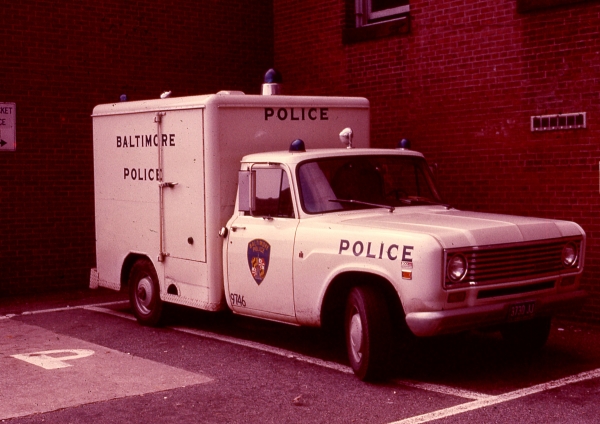
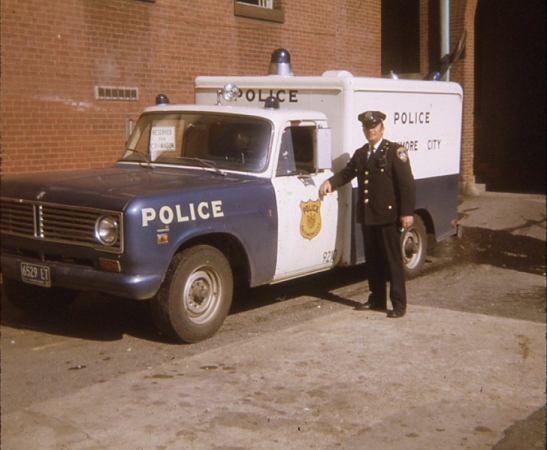

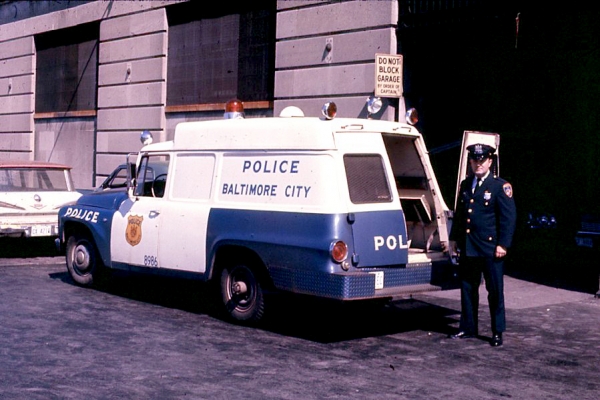 < class="mce-object mce-object-undefined">
< class="mce-object mce-object-undefined">

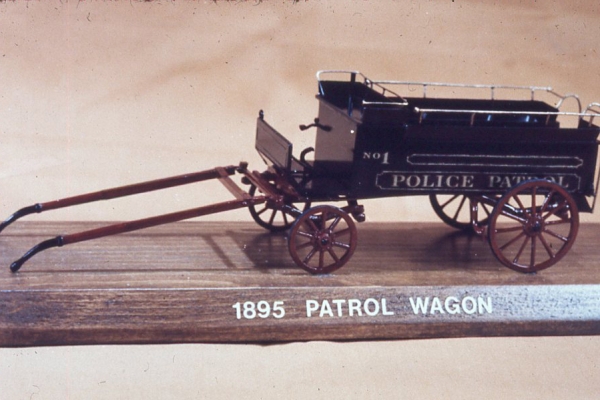



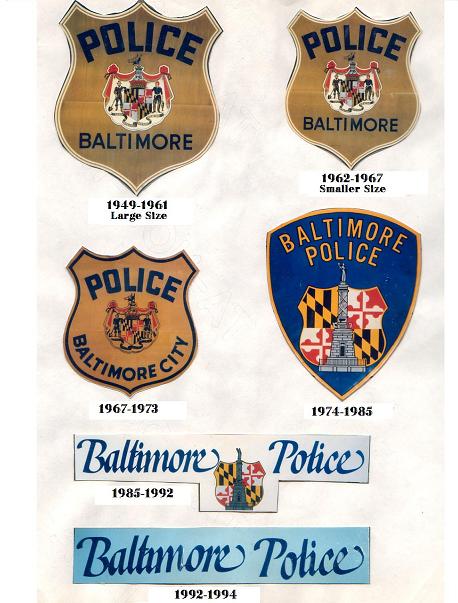
BALTIMORE POLICE DOOR SHIELDS
Cage Cars aka Prisoner Transport Vehicles (PTV)
John Szuba Told us Facebook BPD friends that when he was the vehicle coordinator for the division. He said they conducted tests to see if anyone could get their hand around the "Cage" and attack the Driver. They tried over a half a dozen styles of cages and on everyone. The test was to see if someone in the backseat could reach around and grab at the driver's neck, or could kick out the partition separating back from the front. (These were with the Chevy Impalas). The cage in the Ford Crown Vic was solid but Ford phased out these models and Ford would not loan the new Interceptor to the Department to conduct a test to see if it met Departmental needs. They could only test the Dodge Charger and the Chevy Impala than the Caprice. Officer Szuba said at the time he couldn't sign off on new cage car because he didn't think it was safe for the Officer who would drive it. He went on to say, he, "believe the Prisoner Transport Vans (Wagons) were safer for all concerned". and he personally liked the Old Box style Wagons ....(I agree with his, I also liked the old box wagons better) John went on to say, they were self-contained heat and air for the prisoners and the Drivers air wasn't recycled from the back of the wagon like the Van style.... (This was nice, because it reduced airborne paths that could lead to illness) but it was deemed too expensive. We all I hope the Department conducted a test on the "New" cages...Officer Safety should always be first.

Black Maria/Paddy-Wagon
Pronounced Mah-Rye-Ah
You have the right to remain confounded.
Detectives, come in all shapes, and all sizes, Criminal Detective, History Detective, Medical, and now Word Detectives: All looking for answers, all listening to the clues. Paying attention not to what they want a word to mean, but what it means, do the clues match up with the era, the location, and most importantly the language. So let’s look at a few terms, a few rules, a few rumors, and most importantly a new fact. In the early 1900’s a Prisoner Transport Vehicle, most commonly known today as a “Paddy Wagon”, were often called a “Black Maria” in this country and even in London England… In this article, we will investigate the term “Black Maria” as referred to in relation to the “Paddy Wagon” here in the states. However, it has been said that there have been stories written in Alexander Solzhenitsyn’s books referring to a black car used by the KGB (Russia) for police to secretly take away prisoners in the middle of the night. It has often been wondered where the term came from, rumors have been started; we should note, normally when a rumor comes up that is was a person, and that person exists in similar life form, both in Boston and in Liverpool! Most often, that person is fiction. But for now we will hold judgment until further investigation, as with any investigation, the clues, the evidence, or the facts, might not always go where we want to go, so let’s sit back and let them take us, where they might.
A “Black Maria” is, as they used to say, a police van, truck, or similar conveyance used to transport prisoners most often to jail, holding, prison, or to a court appearance, and it is worth noting at the outset that “Maria” in this case is pronounced “mah-RYE-ah,” as in Mariah Carey (as this was most common in the 19th century, not “Mah-REE-ah.” Then again, “usually” it is a bit of a stretch because few have heard the term spoken aloud in decades. “Paddy Wagon” is far more common.
As is common when phrases involving personal names, a number of theories have been devised, proposed at tracing “Black Maria,” a term which first appeared in print around 1835, to actual people named Maria. A fella by the name of Michael Quinion, has it on his website (www.worldwidewords.org), that two such theories suggested by his readers. One, centering on an upper-class woman of 19th century London, known for wearing splendid black dresses. That version fails due to the simple fact that “Black Maria” is indisputable of American origin. The other, of a large African-American woman named Maria who ran a Boston boarding house and assisted the police in apprehending fugitives, this is too cute for most reads taste and, more importantly, doesn’t explain why a Boston woman would have appeared in New York City.
The most credible theory yet advanced of the origin of “Black Maria” does tie the phrase to an actual “Maria,” but not a human. “Black Maria” was a famous racehorse of the day, born in Harlem in 1826, whose exploits were widely celebrated in the newspapers. It seems entirely plausible that the name of the horse thereafter would be sarcastically applied to the police carriages, which were not long before pulled by horses, and now are often made by the same wagon/carriage makers, and usually colored black, which swiftly transported miscreants to jail.
Note: found elsewhere on the internet - Black Maria, a slang term for a police van used to transport prisoners, originally these were horse-drawn and so could take some time to arrive at a crime scene. “Black Maria” was a famous racehorse of the day, born in Harlem USA in 1826. The name was sardonically applied to the police carriages (which were also usually colored black).
Incidentally, “Paddy Wagon” takes its name from “Paddy,” a familiar form of the name Patrick (from the Irish form, Padraic or Padraig), which was used in early 20th century America as a derogatory term for Irish immigrants. One might assume that this use is similarly derogatory, referring to a supposed propensity of Irish-Americans being arrested, but big city police forces of the period were themselves composed largely of Irish-Americans, so the term may well have simply referred to a wagon driven by “the paddies,” i.e., the police.

Donations
Donations help with web hosting, stamps and materials and the cost of keeping the website online. Thank you so much for helping BCPH.


POLICE INFORMATION
Copies of: Your Baltimore Police Department Class Photo, Pictures of our Officers, Vehicles, Equipment, Newspaper Articles relating to our department and or officers, Old Departmental Newsletters, Lookouts, Wanted Posters, and or Brochures. Information on Deceased Officers and anything that may help Preserve the History and Proud Traditions of this agency. Please contact Retired Detective Kenny Driscoll.
This email address is being protected from spambots. You need JavaScript enabled to view it.

NOTICE
How to Dispose of Old Police Items
Please contact Det. Ret. Kenny Driscoll if you have any pictures of you or your family members and wish them remembered here on this tribute site to Honor the fine men and women who have served with Honor and Distinction at the Baltimore Police Department.
Anyone with information, photographs, memorabilia, or other "Baltimore City Police" items can contact Ret. Det. Kenny Driscoll at This email address is being protected from spambots. You need JavaScript enabled to view it. follow us on Twitter @BaltoPoliceHist or like us on Facebook or mail pics to 8138 Dundalk Ave. Baltimore Md. 21222
Copyright © 2002 Baltimore City Police History - Ret Det Kenny Driscoll




















